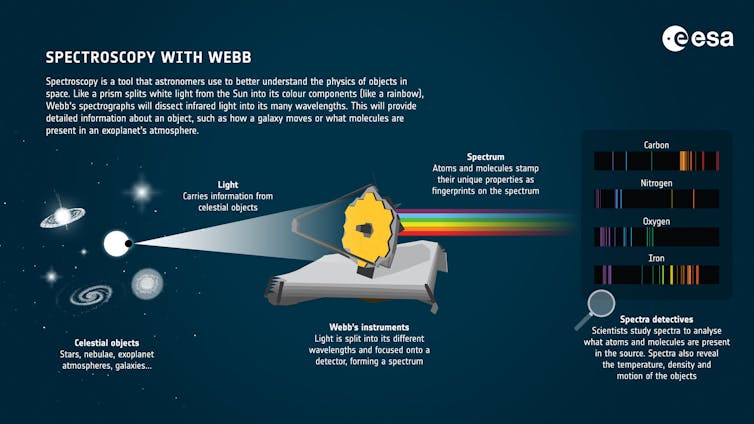
Aurore Simonnet/ Laboratory for Atmospheric and Space Physics/ University of Colorado Boulder
Eryn Cangi, University of Colorado Boulder
Today, the atmosphere of our neighbor planet Venus is as hot as a pizza oven and drier than the driest desert on Earth – but it wasn’t always that way.
Billions of years ago, Venus had as much water as Earth does today. If that water was ever liquid, Venus may have once been habitable.
Over time, that water has nearly all been lost. Figuring out how, when and why Venus lost its water helps planetary scientists like me understand what makes a planet habitable — or what can make a habitable planet transform into an uninhabitable world.

JAXA/ISAS/DARTS/Kevin M. Gill, CC BY
Scientists have theories explaining why most of that water disappeared, but more water has disappeared than they predicted.
In a May 2024 study, my colleagues and I revealed a new water removal process that has gone unnoticed for decades, but could explain this water loss mystery.
Energy balance and early loss of water
The solar system has a habitable zone – a narrow ring around the Sun in which planets can have liquid water on their surface. Earth is in the middle, Mars is outside on the too-cold side, and Venus is outside on the too-hot side. Where a planet sits on this habitability spectrum depends on how much energy the planet gets from the Sun, as well as how much energy the planet radiates away.
The theory of how most of Venus’ water loss occurred is tied to this energy balance. On early Venus, sunlight broke up water in its atmosphere into hydrogen and oxygen. Atmospheric hydrogen heats up a planet — like having too many blankets on the bed in summer.
When the planet gets too hot, it throws off the blanket: the hydrogen escapes in a flow out to space, a process called hydrodynamic escape. This process removed one of the key ingredients for water from Venus. It’s not known exactly when this process occurred, but it was likely within the first billion years or so.
Hydrodynamic escape stopped after most hydrogen was removed, but a little bit of hydrogen was left behind. It’s like dumping out a water bottle – there will still be a few drops left at the bottom. These leftover drops can’t escape in the same way. There must be some other process still at work on Venus that continues to remove hydrogen.
Little reactions can make a big difference
Our new study reveals that an overlooked chemical reaction in Venus’ atmosphere can produce enough escaping hydrogen to close the gap between the expected and observed water loss.
Here’s how it works. In the atmosphere, gaseous HCO⁺ molecules, which are made up of one atom each of hydrogen, carbon and oxygen and have a positive charge, combine with negatively charged electrons, since opposites attract.
But when the HCO⁺ and the electrons react, the HCO⁺ breaks up into a neutral carbon monoxide molecule, CO, and a hydrogen atom, H. This process energizes the hydrogen atom, which can then exceed the planet’s escape velocity and escape to space. The whole reaction is called HCO⁺ dissociative recombination, but we like to call it DR for short.
Water is the original source of hydrogen on Venus, so DR effectively dries out the planet. DR has likely happened throughout the history of Venus, and our work shows it probably still continues into the present day. It doubles the amount of hydrogen escape previously calculated by planetary scientists, upending our understanding of present-day hydrogen escape on Venus.
Understanding Venus with data, models and Mars
To study DR on Venus we used both computer modeling and data analysis.
The modeling actually began as a Mars project. My Ph.D. research involved exploring what sort of conditions made planets habitable for life. Mars also used to have water, though less than Venus, and also lost most of it to space.
To understand martian hydrogen escape, I developed a computational model of the Mars atmosphere that simulates Mars’ atmospheric chemistry. Despite being very different planets, Mars and Venus actually have similar upper atmospheres, so my colleagues and I were able to extend the model to Venus.
We found that HCO⁺ dissociative recombination produces lots of escaping hydrogen in both planets’ atmospheres, which agreed with measurements taken by the Mars Atmosphere and Volatile EvolutioN, or MAVEN, mission, a satellite orbiting Mars.

NASA’s Goddard Space Flight Center
Having data collected in Venus’ atmosphere to back up the model would be valuable, but previous missions to Venus haven’t measured HCO⁺ – not because it’s not there, but because they weren’t designed to detect it. They did, however, measure the reactants that produce HCO⁺ in Venus’ atmosphere.
By analyzing measurements made by Pioneer Venus, a combination orbiter and probe mission that studied Venus from 1978-1992, and using our knowledge of chemistry, we demonstrated that HCO⁺ should be present in the atmosphere in similar amounts to our model.
Follow the water
Our work has filled in a piece of the puzzle of how water is lost from planets, which affects how habitable a planet is for life. We’ve learned that water loss happens not just in one fell swoop, but over time through a combination of methods.
Faster hydrogen loss today via DR means that less time is required overall to remove the remaining water from Venus. This means that if oceans were ever present on early Venus, they could have been present for longer than scientists thought before water loss through hydrodynamic escape and DR started. This would provide more time for possible life to arise. Our results don’t mean oceans or life were definitely present, though – answering that question will require lots more science over many years.
There is also a need for new Venus missions and observations. Future Venus missions will provide some atmospheric measurements, but they won’t focus on the upper atmosphere where most HCO⁺ dissociative recombination takes place. A future Venus upper atmosphere mission, similar to the MAVEN mission at Mars, could vastly expand everyone’s knowledge of how terrestrial planets’ atmospheres form and evolve over time.
With the technological advancements of recent decades and a flourishing new interest in Venus, now is an excellent time to turn our eyes toward Earth’s sister planet.![]()
Eryn Cangi, Research Scientist in Astrophysical & Planetary Sciences, University of Colorado Boulder
This article is republished from The Conversation under a Creative Commons license. Read the original article.























































